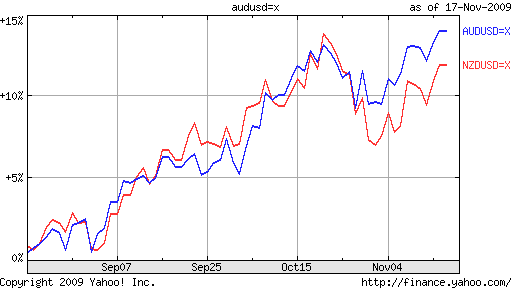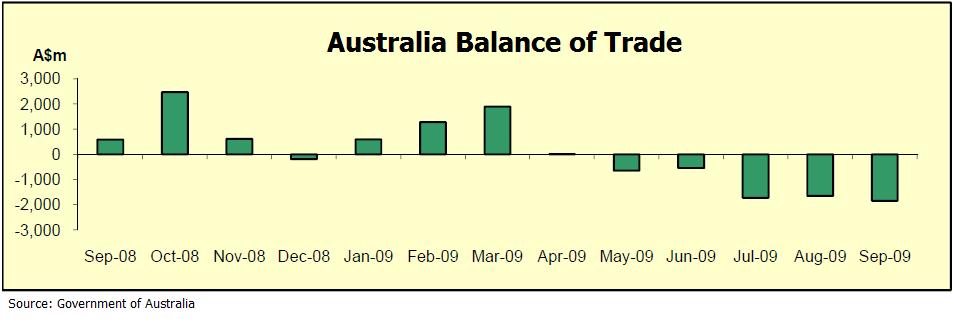November 18th 2009
Kiwi and Aussie Diverge, then Re-Unite
Over the last few months, the New Zealand Dollar and Australian Dollar have largely moved in tandem (see chart below). When the Reserve Bank of Australia raised its benchmark interest rate earlier this month, it shocked the markets and the Aussie shot up, while the Kiwi remained fixed in place. Many observers predicted that such was the beginning of a divergence in the two currencies. Less than one week later, however, the New Zealand Dollar hitched itself back to the Australian Dollar, and the two currencies have since traded in lockstep.

Investors have long tended to view the currencies (and economies) of New Zealand and Australia as one. Both economies boast large export sectors, and for much of the last decade, high interest rates. Given that the carry trade has been (and continues to be) one of the largest forces in forex markets, it makes sense that the Kiwi and Aussie would be grouped together.
Both these superfical similarities mask substantive differences, which have only become more accentuated as a result of the global economic crisis. Alan Bollard, Governor of the Bank of New Zealand summarized this disparity as follows: “Australia has avoided negative growth, and its prospects are driven by strong terms of trade, vast mineral deposits, the Chinese market, and rapid population growth. New Zealand has had a recession, and the pick-up is slower and more vulnerable – a difference financial markets do not appear to appreciate.”
While both economies are currently experiencing negative trade imbalances, New Zealand’s deficit was 5.9% at last count, while Australia’s is closer to 2%. Given that Australia’s (energy and commodity) exports have surged by nearly 30% in the last few months, while New Zealand exports are stagnating, this discrepancy could widen in the coming months. Investment is also surging in Australia, as “The value of advanced resource projects — those that are either committed or under construction — jumped 41% to a record 112.46 billion Australian dollars (US$104.03 billion) in the six months to the end of October.” And of course, the most obvious point of differentiation is between the two economies’ respective benchmark interest rates. Thanks to the aforementioned rate hike, Australian rates stand at 3.5%, exactly 1% higher than comparable New Zealand rates.

Many analysts point to Australia’s improving fundamentals (higher rates, positive GDP growth, booming investment in the energy sector, increasing exports) as the basis for the strong appreciation in the Australian Dollar. Given that the New Zealand Dollar has kept pace with the Australian Dollar (it is in fact the world’s best performing “major currency” over the last six months), this kind of analysis seems dubious, if not completely irrelevant.
It should be clear to most observers that the carry trade is dominating activity in the forex markets. Carry traders, relatively speaking, are undiscriminating, with the main factor of importance being interest rate differentials. Despite the fact that New Zealand interest rates are only 2.5% higher than US rates (and actually less than Australian rates) – hardly enough to compensate investors for volatility risk – the markets are awash in liquidity, and investors are once again chasing yield wherever they can find it.
One analyst offered a frank summary of this phenomenon: “It’s all about the carry trade. The Fed can’t do anything; certainly they can’t raise rates and the market knows that, and is exploiting it for the carry trade, borrowing in U.S. dollars, and the Kiwi is a beneficiary of that…That’s the only game in town. You can forget most economic data, it’s all about…the Fed.” Given that Australian rates are projected to rise faster and higher than New Zealand rates (beginning as soon as December 1), it’s conceivable that the Aussie will outpace the Kiwi. At the same time, the fact that US interest rates will likely remain low for a while means that both currencies will continue to benefit in the short term.



